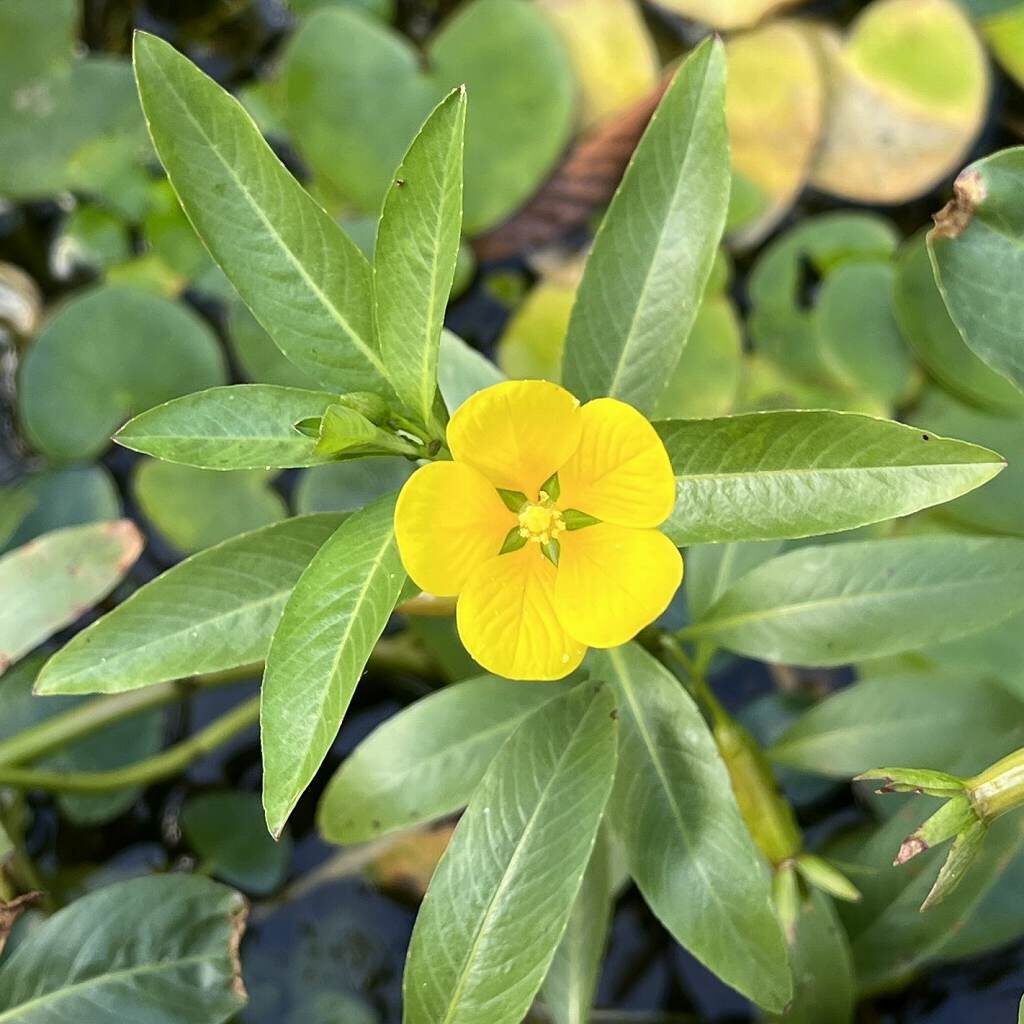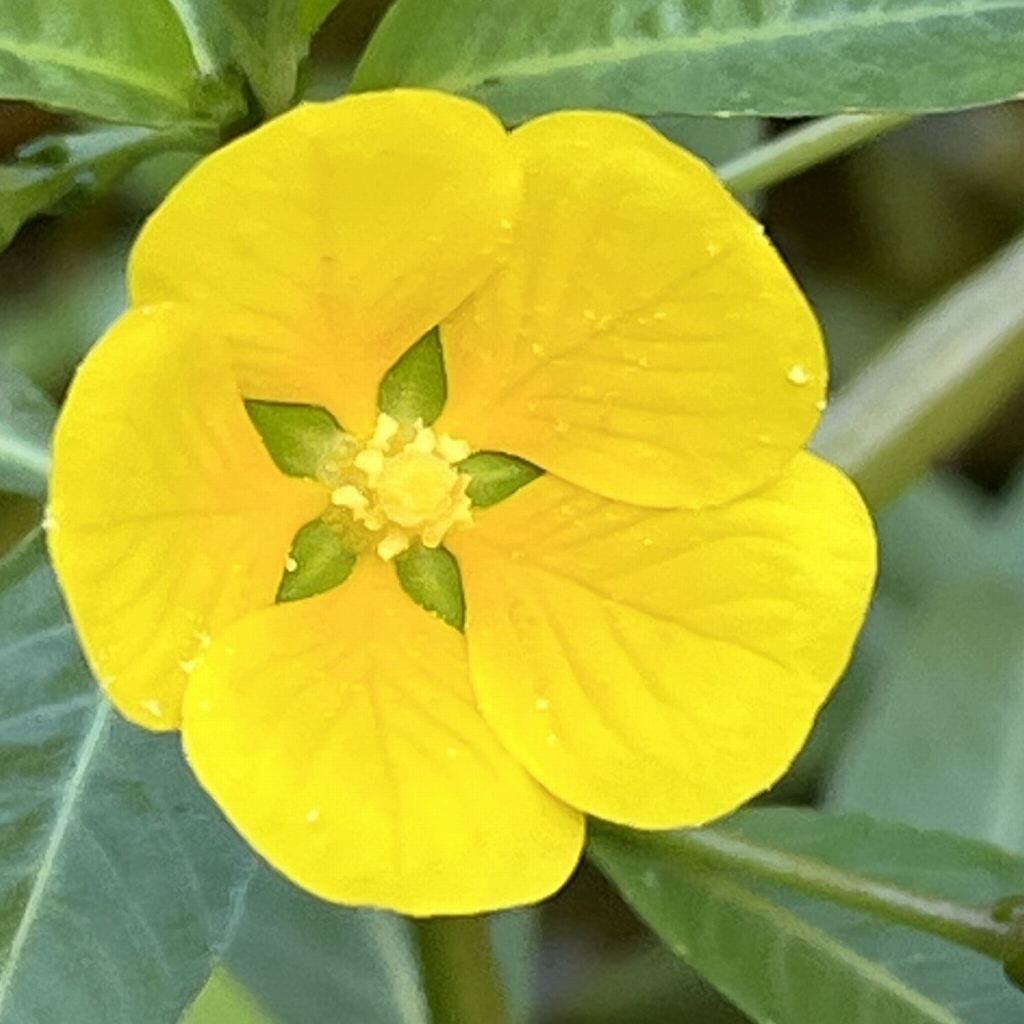ミズキンバイの名前の由来は水辺に生えていて、高山植物の「金梅草」に似た花を咲かせるから。また、花が金の盃のように見えるからです。
Floating Primrose Willow’s Japanese name, “Water Golden Plum”, comes from the fact that it grows near water and has flowers that resemble the alpine plant Trollius, whose Japanese name is “Golden Plum Grass”. Also, because the flower looks like a cup of gold.
【仮名】ミズキンバイ
【和名】水金梅
【英名】Floating Primrose Willow
【学名】Ludwigia stipulacea
【誕生】08/ 09
【開花】07, 08, 09, 10月
【花色】Yellow




ミズキンバイ
ミズキンバイの来歴
ミズキンバイはアカバナ科チョウジタデ属の多年草。日本では本州から四国、九州まで、国外では台湾、中国で自生しています。河川の氾濫など、生育環境の攪乱によって水辺や湿地に群落を形成。日本では河川の整備などで衰退し、絶滅の恐れもあるため、保全が進められています。
ミズキンバイの名前
ミズキンバイの名前の由来は水辺に生えていて、高山植物の「金梅草」に似た花を咲かせるからです。また、花が金の盃のようだから。英名のフローティング・プリムローズ・ウィロウは豪州から北米、南米まで自生する同属異種です。欧州では厄介な雑草として侵略的外来種に指定。
ミズキンバイの茎と根
ミズキンバイの茎は水中を浮きながら、または地表を這いながら伸び広がり、節から支持根や通気根を伸ばします。日光を遮られると生育できないため、河川の氾濫などで草丈の高い「葦」や「蒲」などが薙ぎ倒されると、千切れた茎から萌芽したり、土中に潜む種子が発芽して繁殖。
ミズキンバイの葉と花
ミズキンバイの葉は互生し、長楕円形で光沢があります。花は朝方咲いて夕方しぼむ一日花。花冠は先端の凹んだ花弁が5枚、雄しべが10本、雌しべが5裂、中央に毛が密生します。花後の果実は蒴果ですが、熟しても裂けずに落下。土中で果皮が分解してから中の種子を散らします。
ミズキンバイの近縁
ミズキンバイと英名が同じ近縁種「小葉水金梅」は姿形がよく似ています。また、「大花水金梅」は花の大きな近縁種。原産地の南米から日本に持ち込まれて野生化し、特定外来生物にも指定されています。「鰭田牛蒡」も別名「アメリカ水金梅」という帰化種。花は花弁が4枚です。
Floating Primrose Willow
Origin of Floating Primrose Willow
Floating Primrose Willow is a perennial plant belonging to the family Onagraceae. In Japan, it grows wild from Honshu to Shikoku and Kyushu, and outside of Japan, it grows wild in Taiwan and China. It forms colonies along watersides and marshes due to disturbances in the growing environment such as flooding of rivers. However, in Japan, due to river development, etc., the number of these species has decreased dramatically, and there is a danger of extinction, so conservation efforts are underway.
Name of Floating Primrose Willow
Floating Primrose Willow’s Japanese name, “Water Golden Plum”, comes from the fact that it grows near water and has flowers that resemble the alpine plant Trollius, whose Japanese name is “Golden Plum Grass”. Also, because the flower looks like a cup of gold. The English name Floating Primrose Willow is a species of the same genus that grows naturally from Australia to North America and South America. Designated as an invasive alien species in Europe as a troublesome weed.
Stems and roots of Floating Primrose Willow
The stems of Floating Primrose Willow grow floating in water or crawling on the ground, and support roots and aerating roots are extended from the nodes. Because they cannot grow if they are blocked from sunlight, when tall plants such as reeds and common cattails are washed away by river floods, they sprout from chopped stems and seeds hidden in the ground germinate and propagate.
Leaves and flowers of Floating Primrose Willow
The leaves of Floating Primrose Willow are alternate, oblong and glossy. The flower blooms in the morning and wilts in the evening. The corolla has 5 petals with dented tips, 10 stamens, and the pistil has 5 lobed style, densely hairy in the center. The fruit after flowering is a capsule, but it does not split and falls off even when ripe. After the pericarp decomposes in the soil, the seeds inside are scattered.
Close relatives of Floating Primrose Willow
The closely related species “Ludwigia peploides”, which has the same English name as Floating Primrose Willow, is very similar in appearance. In addition, “Ludwigia grandiflora” is a related species with large flowers. It was brought to Japan from its native South America and became wild, and has been designated as a specific alien species. “Ludwigia decurrens” is also a naturalized variety called “American Floating Primrose Willow”. The flower has four petals.


